Historical Images: Ibn Sina and His Canon of Medicine
“THE ENDURING RESPECT IN THE 21ST CENTURY FOR A BOOK WRITTEN A MILLENIUM EARLIER IS A TESTIMONY TO IBN SINA’S ACHIEVEMENT” – Mona N. Tibi and Emilie Savage-Smith
Compiled by Malik Merchant
Editor, Simergphotos.com & Simerg.com
INTRODUCTION: On Sunday November 25, 2012, Simergphotos began a weekly/bi-weekly series of historical illustrations that underline an artistic, ethical, moral, religious or scientific theme. This third piece in the series is based on Wellcome Library’s Arabic manuscript collection, and includes the well-known medical encyclopedia, the Canon of Medicine, by the famous Ismaili practitioner Ibn Sina, also known as Avicenna.

Portrait of Avicenna, Medicin, Chap. 134. Engraving, early 17th cent.(?). Many physicians in the Islamic world were outstanding medical teachers and practitioners. Avicenna (980-1037 CE) was born near Bokhara in Central Asia. Known as the ‘Prince of Physicians’, his Canon of Medicine (medical encyclopedia) remained the standard text in both the East and West until the 16th century and still forms the basis of Unani theory and practice today. Credit: Wellcome Library/Wellcome Images. Copyright.
Abu Ali al-Husayn Ibn Abdullah Ibn Sina was born in Bukhara in 980. Sometimes known in the West by the Latin name, Avicenna, this Persian physician became the most famous and influential of all the Islamic philosopher-scientists. He earned royal favour for treating the Kings of Bukhara and Hamadan for ailments other physicians could neither diagnose nor cure. His grave is still maintained in Hamadan, where he died in 1037. Though trained as a physician, Ibn Sina made important contributions to philosophy, mathematics, chemistry, and astronomy.
My father was one of those who had responded to the invitation of the Egyptians and was counted among the Isma’ilis. He had accepted their opinions on the soul and on the intellect. My brother likewise. They often discussed these matters. I listened to them, I grasped what they were saying, and they tried to attract me to their rite…..Avicenna, excerpt from UNESCO Courier, Special Avicenna Issue, October 1980.
~~~~
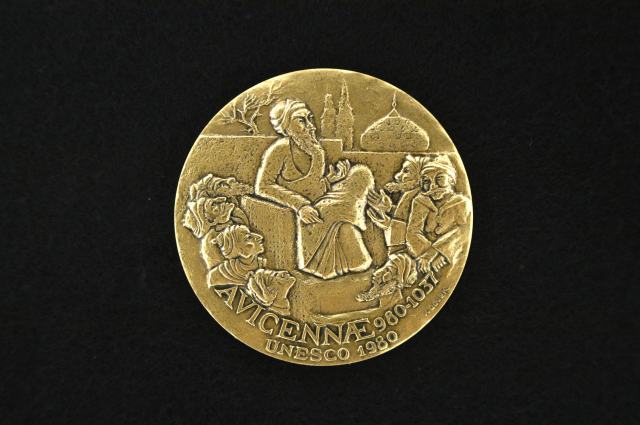
To mark the 1,000th birth anniversary of the most influential of Islam’s philosopher-scientists, UNESCO minted this commemorative medal in 1980. Abu Ali al-Husain Ibn Abdallah Ibn Sina was known in Europe as Avicenna. A healer and a humanist, Avicenna developed an exemplary holistic approach that captures the essence of ethics in science and has thus come to serve as a source of inspiration for the promotion of this concern, which is of central importance to UNESCO. Designed by sculptor-medallist Victor Douek, the obverse depicts a scene showing Avicenna surrounded by his disciples, inspired by a miniature in a 17th-century Turkish manuscript.
Ibn Sina’s most enduring legacy was in the field of medicine. His most famous book, Qanun fi’l-tibb (“The Canon of Medicine”) is still one of the most important medical books ever written, and served as the medical authority throughout Europe for 600 years. Among the Canon’s contributions to modern medicine was the recognition that tuberculosis is contagious; diseases can spread through water and soil; and a person’s emotional health influences his or her physical health. Ibn Sina was also the first physician to describe meningitis, parts of the eye, and the heart valves, and he found that nerves were responsible for perceived muscle pain. He also contributed to advancements in anatomy, gynecology, and pediatrics…..Excerpt from The Islamic World to 1600, The University of Calgary, 1998, The Applied History Research Group.
~~~~
AVICENNA’S LEGEND ABOUT THE LOVESICK PRINCE

A physician talking to a patient in a garden. A lacquered binding board cover of the Canon of Medicine, 1632. Credit: Wellcome Library/Wellcome Images. Copyright.
The lacquer miniature on the cover of Avicenna’s ‘Canon’ depicts a youth and a physician who takes his pulse, while beside sits a young girl and two other physicians preparing medicine. It has been thought that this is an illustration of a legend about Avicenna (died 1037) and a certain young prince of Gurgan (by the Caspian Sea) who became sick of a malady which nobody could treat. Avicenna was invited to give his opinion. By keeping his finger on the youth’s pulse, he requested that someone who knew all the towns of the province should repeat their names. At the mention of a certain town, he felt a flutter in the pulse. “Now”, he said, “Let someone mention all the houses, streets, and quarters of the town”. Again, a certain street was mentioned and the same phenomenon was repeated; and a third time, when the names of the inhabitants of a certain household were enumerated, it came out that the youth was in love with a girl. The therapy suggested by Avicenna was to allow the couple to get married….Excerpt from the Wellcome Library.
~~~~
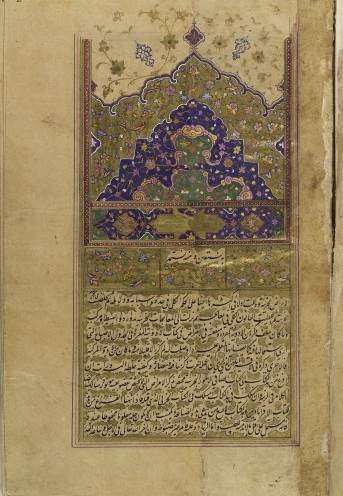
Text and Painting, 1632, from Canon of Medicine, Qanun fi’l-tibb, by Ibn Sina, Published: Isfahan folio 2 recto Credit: Wellcome Library/Wellcome Images, London. Copyright.
One of the most famous exponents of Muslim universalism and an eminent figure in Islamic learning was Ibn Sina, known in the West as Avicenna (981-1037). For a thousand years he has retained his original renown as one of the greatest thinkers and medical scholars in history. His most important medical works are the Qanun (Canon) and a treatise on Cardiac drugs. The ‘Qanun’ is an immense encyclopedia of medicine. It contains some of the most illuminating thoughts pertaining to distinction of mediastinitis from pleurisy; contagious nature of phthisis; distribution of diseases by water and soil; careful description of skin troubles; of sexual diseases and perversions; of nervous ailments….George Sarton, Introduction to the History of Science
~~~~

The Canon of Mediicin is divided into five books. This opening shows the start of the third book depicting diseases of the brain. Credit: Wellcome Library/Wellcome Images, London. Copyright.
_____________
LATIN VERSION OF THE CANON AND TRIBUTES TO AVICENNA
The Canon was translated into Latin in the 12th century by Gerard of Cremona. Its encyclopaedic content, its systematic arrangement and philosophical plan soon worked its way into a position of pre-eminence in the medical literature of Europe, displacing the works of Galen and becoming the text book for medical education in the schools of Europe. The text was read in the medical schools at Montpellier and Leuven as late as 1650, and Arnold C. Klebs described it as “one of the most significant intellectual phenomena of all times.” No other medical book has remained so highly acclaimed for such a long period of time. When the Arabic original was published in Rome in 1593, it became one of the first Arabic books to be produced on the new invention of the printing press.

A Latin copy of The Canon of Medicine, dated 1484, located at the P.I. Nixon Medical Historical Library of The University of Texas Health Science Center at San Antonio, USA. Credit: Wikipedia.
The influential Canadian physician, Sir William Osler, described the Canon as “the most famous medical textbook ever written” noting that it remained “a medical bible for a longer time than any other work.”
In 2006, Professor John Urquhart noted the relevance of the Canon to modern medicine, comparing it to an influential medical work of the 19th century, The Principles and Practice of Medicine (1892) by Osler himself, and concluded:
If the year were 1900 and you were marooned and in need of a guide for practical medicine, which book would you want by your side?” My choice was Ibn Sina. A leading reason is that Ibn Sina gives an integrated view of surgery and medicine, whereas Osler largely shuns intervention. Ibn Sina, for example, tells how to judge the margin of healthy tissue to take with an amputation, a basic topic uncovered by Osler. The gap between medicine and surgery is now closing, with the advent of interventional cardiology, gastroenterology, radiology, etc. Ibn Sina correctly saw medicine and surgery as one.

Detail of a Woodcut depicting ancient herbalists and scholars of medicinal lore “Herophilus and Erasistratus” from Iconographic, Ancient herbalists and scholars of medicinal lore (Galen, Pliny, Hippocrates etc.); and Venus and Adonis in the gardens of Adonis by Lorenz Fries Published: Balthazar BeekStrasburg 1532. Avicenna and Rhazes are shown on the 4th row, last column. Credit: Wellcome Library/Wellcome Images, London. Copyright.
~~~~
Illustrations showing cupping, dislocation and massage from Liber canonis, de medicinis cordialibus, et cantica by Avicenna Published: J. Hervagius Basle 1556, pages 893-94. Credit: Wellcome Library/Wellcome Images, London. Copyright.
_______________
ANATOMY
No anatomical illustrations of the entire human body are preserved from the Islamic world before those in the Persian treatise composed by Mansur ibn Muhammad ibn Ahmad ibn Yusuf ibn Ilyas in the end of the 14th century. His illustrated work, ‘Tashrihi badani insan’, or ‘Anatomy of the Human body’, is often called ‘Mansur’s Anatomy’ (Tashrihi Mansuri). Normally, there were five diagrams illustrating each bodily ‘system’ (bones, nerves, muscles, veins, and arteries). It should be noted that many such diagrams have two simultaneous projections: the body is depicted in the frontal view while the head is reversed, as seen from behind.
These illustrations became very popular in various Arabic or Persian medical treatises, and were often included in works to which they originally did not belong. That is the case of this Arabic manuscript: here, the text of Avicenna’s ‘Canon’ is illustrated by the diagrams that originate from the ‘Tashrihi Mansuri’….Excerpts from the Wellcome Library.
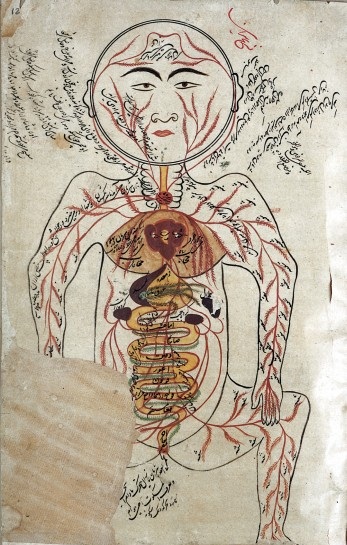
An illustration of arteries and viscera based on ‘Mansur’s Anatomy’ in the ‘Canon’ of Avicenna, Qanun fi’l-tibb, by Ibn Sina (Avicenna), Published: Isfahan, Folio 123 verso. Credit: Wellcome Library/Wellcome Images, London. Copyright.
~~~~

An illustration of the skeleton system based on ‘Mansur’s Anatomy’ in the ‘Canon’ of Avicenna, Qanun fi’l-tibb, by Ibn Sina (Avicenna), Published: Isfahan Folio 126 recto. Credit: Wellcome Library/Wellcome Images, London. Copyright.
~~~~

An illustration of the nervous system based on ‘Mansur’s Anatomy’ in the ‘Canon’ of Avicenna, Qanun fi’l-tibb, by Ibn Sina (Avicenna), Published: Isfahan, Folio 123 verso. Credit: Wellcome Library/Wellcome Images, London. Copyright.
~~~~
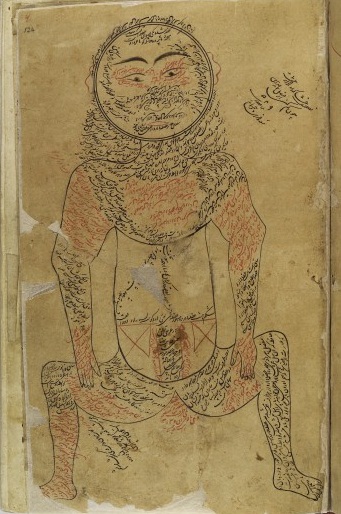
An illustration of the muscular system based on ‘Mansur’s Anatomy’ in the ‘Canon’ of Avicenna, Qanun fi’l-tibb, by Ibn Sina (Avicenna), Published: Isfahan, Folio 123 verso. Credit: Wellcome Library/Wellcome Images, London. Copyright.
__________
AVICENNA — CLAIMED BY EVERYONE, INCLUDING THE ISMAILIS, AS ONE OF THEIR OWN
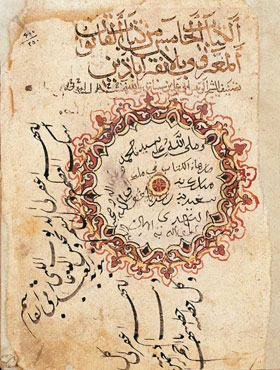
The Aga Khan Museum collection includes probably the earliest extant manuscript of volume 5 of the Canon of Medicine of Ibn Sina (Avicenna) dated 1052 CE. Its origins date to the early 11th century Iran, but it eventually was used all over the Middle East and Europe as the standard medical text for 500 years. The Canon formed the basis of medical teaching at European universities until the beginning of modern times. Credit: Aga Khan Museum Collection.
Just as Arabs, Turks and Persians all like to claim Avicenna as their own, the Ismailis like to consider him to be a part of their own tradition.
Mumtaz Ali Tajddin Sadik Ali, a prolific Ismaili author based in Pakistan, mentions that during the 1983 commemoration of the Silver Jubilee of the current Ismaili Imam, His Highness the Aga Khan, a gift of a Chair at the Aga Khan University was offered by the President of the Aga Khan National Council for Pakistan, Vazir Ashiqali, on behalf of the Ismailis of Pakistan. His Highness the Aga Khan graciously accepted the gift on behalf of the Aga Khan University and said that the Chair should be named after one of Islam’s great philosophers or scientists, so that his memory may be kept alive in an academic institution of higher learning today. In 1985, His Highness further recommended to the Board of Trustees that the name “be of a great man in our history, in our tariqah.” In November 1988, the Ismaili Imam named the Chair of Professorship of Medicine after Abu Ali Ibn Sina.
The Ismailis therefore have a good reason for treating Avicenna as one of their own. Please also see A Brief Discussion on Avicenna’s Madhab
Date posted: Sunday, December 16, 2012.
____________
With the exception of three images from UNESCO, Wikipedia and the Aga Khan Museum Collection, all the remaining images in the above piece on Avicenna are from the website of The Wellcome Trust, a UK based charity funding institution for research to improve human and animal health by supporting the brightest minds in biomedical research and the medical humanities. In addition to funding biomedical research, it supports the public understanding of science. In the field of medical research, it is the world’s second largest private funder after Bill & Melinda Gates Foundation. Please visit their website by clicking http://www.wellcome.ac.uk/.
____________
Profile of Malik Merchant at Contributors.
Simergphotos’ historical images series (previous posts):
Historical Images: President Thomas Jefferson’s Copy of the Qur’an
Historical Images: The American Declaration of Independence Illustrated
Ibn Sina Academy is planning to hold an “International Conference on Life & Contribution of Ibn Sina (Avicenna)” during 25-27 October 2014, in Aligarh to commemorate the 1000th Anniversary of the Compilation of Ibn Sina’s Kitab al-Qanun fi at-Ṭibb (The Canon of Medicine).The idea is actually to review Ibn Sina’s multidimensional personality and to span his contributions in the field of science, philosophy, literature and all branches of medicine in particular. The forthcoming conference will bring together expert scholars to discuss topics on various themes. A tentative list is as follows.
1. Ibn Sina as a physician and his works on all branches of medicine,
2. Ibn Sina as a natural scientist: Compiler of Kitâb al–Shifâ’,
3. Ibn Sina as a philosopher, geographer, poet, and commentator of Quranic Sura,
4. Ibn Sina’s impact on his own contemporary scientists,
5. Studies on Ibn Sina in India,
6. Studies on Ibn Sina in European universities during medieval and renaissance periods,
7. Relevance of Ibn Sina in modern era.
The programme will comprise invited lectures, besides oral and posters’ presentations.
Participants are requested to present a paper in any area of their expertise. Please inform us the title of your talk as early as possible. We shall appreciate, if you send your abstract of not more than 300 words until 16 July 2014.
Looking forward to active participation of scholars in making this event a grand success, and waiting for a prompt response,
Prof. H. S. Zillur Rahman
(Organising Chairman)
Prof. S. M. Razaullah Ansari
(Organising Secretary)
Dr. Abdul Moiz Shams
(Co-Organising Chairman)
Dr. Syed Ziaur Rahman
(Joint Organising Secretary)
The work of Ibn Sina is marvellous for our generation as educational point of view. I was really privileged to know such a great scientist is from the Muslim community.
Yes, it needed to be reminded that Avicenna was born in an Ismaili family, a fact often forgotten. We know Avicenna in medicine and philosophy, but he was also a mystic as the beautiful poem of the Soul illustrates that. Years or even decades ago, The Unesco Courier published a beautiful monography on this great scholar. It needs another publication. I wonder if Henry Corbin’s book on Avicenna’s mystical thought has been translated into English. The scholar highlights the influence of Shi’ism on Avicenna philosophy.
In the December special issue of the Scientific American Mind on Genius, I was surprised that Avicinna ‘s name was not mentioned. Ibn Khauldin was though. Others that were mentioned were da Vinci, Archimedes, Newton Mozart , Austen, Edison , Leibniz , etc. Thank you for this series, Malik.
Best wishes for the New Year
ZUL